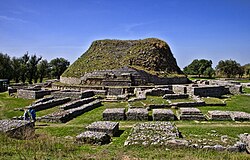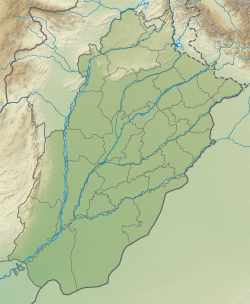
Back ታክሲላ Amharic تاكسيلا Arabic تاكسيلا ARZ তক্ষশীলা Assamese Таксила Bulgarian তক্ষশীলা Bengali/Bangla Tàxila Catalan Taxila Czech Taxila Danish Taxila German
Taxila
ٹيکسلا | |
|---|---|
 | |
| Coordinates: 33°44′45″N 72°47′15″E / 33.74583°N 72.78750°E | |
| Country | |
| Province | |
| Division | Rawalpindi Division |
| District | Rawalpindi District |
| Tehsil | Taxila Tehsil |
| Elevation | 549 m (1,801 ft) |
| Population (2017) | |
| • Total | 85,000[1] |
| Time zone | UTC+5:00 (PKT) |
| Postal code | 47080 |
| Dialing code | 596 |
| Criteria | iii, vi |
| Designated | 1980 |
| Reference no. | 139 |
Taxila or Takshashila (Punjabi and Urdu: ٹيکسلا; Sanskrit: तक्षशिला, 𑀢𑀓𑁆𑀱𑀰𑀺𑀮𑀸; Pali: Takkasilā; Ashokan Prakrit: 𑀢𑀔𑀲𑀺𑀮𑀸, Takkhasilā; Greek: Τάξιλα, Táxila)[2] is a city in the Pothohar region of Punjab, Pakistan. Located in the Taxila Tehsil of Rawalpindi District, it lies approximately 25 kilometres (16 mi) northwest of the Islamabad–Rawalpindi metropolitan area and is just south of the Haripur District of Khyber Pakhtunkhwa.
Old Taxila was for a time the capital city of ancient Gāndhāra, situated on the eastern shore of the Indus River—the pivotal junction of the Indian subcontinent and Central Asia;[3] it was founded around 1000 BCE. Some ruins at Taxila date to the time of the Achaemenid Persian Empire. In 326 BCE, the city was conquered by Alexander the Great who gained control of the city without a battle since the city was immediately surrendered to the Macedonian Empire. This was followed successively by the Maurya Empire, the Indo-Greek Kingdom, the Indo-Scythians, and the Kushan Empire. Owing to its strategic location, Taxila has changed hands many times over the centuries, with many polities vying for its control. When the great ancient trade routes connecting these regions ceased to be important, the city sank into insignificance and was finally destroyed in the 5th century by the invading Hunas. In mid-19th century British India, ancient Taxila's ruins were rediscovered by British archaeologist Alexander Cunningham and extensively excavated by Sir John Marshall. In 1980, UNESCO designated Taxila as a World Heritage Site.[4]
By some accounts, the University of ancient Taxila is considered to be one of the earliest universities or education centre in South Asia.[5][6][7][8][9] Other scholars do not consider it to have been a university in the modern sense, in that the teachers living there may not have had official membership of particular colleges, and there did not seem to have existed purpose-built lecture halls and residential quarters in the city. In a 2010 report, the Global Heritage Fund identified Taxila as one of 12 worldwide sites that were "on the verge" of irreparable loss and damage, citing insufficient management, development pressure, looting, and armed conflict as primary threats.[10] However, significant preservation efforts have since been carried out by the Pakistani government, which has resulted in the site's recategorization as "well-preserved" by different international publications.[11] Because of the extensive preservation efforts and upkeep, Taxila is one of Punjab's popular tourist spots, attracting up to one million tourists every year.[11][12]
- ^ "Administrative Units" (PDF). Archived from the original (PDF) on 28 February 2020. Retrieved 15 August 2023.
- ^ The name for the city of Taxila as it appears in the Heliodorus Pillar inscription, circa 100 BCE.
- ^ Raymond Allchin, Bridget Allchin, The Rise of Civilization in India and Pakistan. Cambridge University Press, 1982 p.127 ISBN 052128550X
- ^ UNESCO World Heritage Site, 1980. Taxila: Multiple Locations. Retrieved 13 January 2007.
- ^ Needham, Joseph (2004). Within the Four Seas: The Dialogue of East and West. Routledge. ISBN 978-0-415-36166-8.
- ^ Kulke & Rothermund 2004:
"In the early centuries the centre of Buddhist scholarship was the University of Taxila."
- ^ Balakrishnan Muniapan, Junaid M. Shaikh (2007), "Lessons in corporate governance from Kautilya's Arthashastra in ancient India", World Review of Entrepreneurship, Management and Sustainable Development 3 (1):
"Kautilya was also a Professor of Politics and Economics at Taxila University. Taxila University is one of the oldest known universities in the world and it was the chief learning centre in ancient India."
- ^ Mookerji 1989, p. 478:
"Thus the various centres of learning in different parts of the country became affiliated, as it were, to the educational centre, or the central university, of Taxila which exercised a kind of intellectual suzerainty over the wide world of letters in India."
- ^ Mookerji 1989, p. 479:
"This shows that Taxila was a seat not of elementary, but higher, education, of colleges or a university as distinguished from schools."
- ^ "Global Heritage in the Peril: Sites on the Verge". Global Heritage Fund. Archived from the original on 20 August 2012.
- ^ a b Raheela Nazir (12 May 2018). "Feature: Pakistan in efforts to rejuvenate Taxila, one of most important archaeological sites in Asia". XINHUANET.com. Archived from the original on 11 May 2018. Retrieved 15 October 2018.
- ^ "Taxila: an illustration of fascinating influences of multiple civilisations". Daily Times. 13 May 2018.
© MMXXIII Rich X Search. We shall prevail. All rights reserved. Rich X Search

